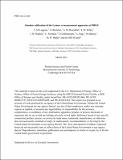| dc.contributor.author | Laggner, F.M. | en_US |
| dc.contributor.author | Bortolon, A. | en_US |
| dc.contributor.author | Rosenthal, Aaron M. | en_US |
| dc.contributor.author | Wilks, Theresa M. | en_US |
| dc.contributor.author | Hughes, Jerry W. | en_US |
| dc.contributor.author | Freeman, C. | en_US |
| dc.contributor.author | Golfinopoulos, T. | en_US |
| dc.contributor.author | Nagy, A. | en_US |
| dc.contributor.author | Mauzey, D. | en_US |
| dc.contributor.author | Shafer, M.W. | en_US |
| dc.contributor.author | DIII-D Team | en_US |
| dc.date.accessioned | 2025-03-21T20:21:51Z | |
| dc.date.available | 2025-03-21T20:21:51Z | |
| dc.date.issued | 2021-03 | |
| dc.identifier | 21ja060 | |
| dc.identifier.uri | https://hdl.handle.net/1721.1/158714 | |
| dc.description | Submitted for publication in Review of Scientific Instruments | |
| dc.description.abstract | The LLAMA (Lyman-Alpha Measurement Apparatus) diagnostic was recently installed on the DIII-D tokamak [Rosenthal et al., Rev. Sci. Instrum. (submitted) (2020)]. LLAMA is a pinhole camera system with a narrow band Bragg mirror, a bandpass interference filter, and an absolute extreme ultraviolet photodiode detector array, which measures the Ly-α brightness in the toroidal direction on the inboard, high field side (HFS) and outboard, low field side (LFS). This contribution presents a setup and a procedure for an absolute calibration near the Ly-α line at 121.6 nm. The LLAMA in-vacuum components are designed as a compact, transferable setup that can be mounted in an ex situ vacuum enclosure that is equipped with an absolutely calibrated Ly-α source. The spectral purity and stability of the Ly-α source are characterized using a vacuum ultraviolet spectrometer, while the Ly-α source brightness is measured by a NIST-calibrated photodiode. The non-uniform nature of the Ly-α source emission was overcome by performing a calibration procedure that scans the Ly-α source position and employs a numerical optimization to determine the emission pattern. Nominal and measured calibration factors are determined and compared, showing agreement within their uncertainties. A first conversion of the measured signal obtained from DIII-D indicates that the Ly-α brightness on the HFS and LFS is on the order of 1020 Ph sr^{−1} m^{−2} s^{−1}. The established calibration setup and procedure will be regularly used to re-calibrate the LLAMA during DIII-D vents to monitor possible degradation of optical components and detectors. | |
| dc.publisher | AIP | en_US |
| dc.relation.isversionof | doi.org/10.1063/5.0038134 | |
| dc.source | Plasma Science and Fusion Center | en_US |
| dc.title | Absolute calibration of the Lyman- α measurement apparatus at DIII-D | en_US |
| dc.type | Article | en_US |
| dc.contributor.department | Massachusetts Institute of Technology. Plasma Science and Fusion Center | |
| dc.relation.journal | Review of Scientific Instruments | |
